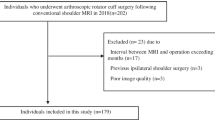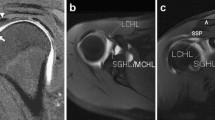Abstract
Objective
To evaluate the diagnostic performance and reliability of magnetic resonance of arthrography (MRA) in diagnosis of subscapularis (SSC) tendon tears between two reviewers with varying levels of experience, and compare the results with clinical tests.
Materials and methods
SSC tendons were retrospectively evaluated in a total of 272 patients with arthroscopic confirmations. A total of 548 shoulder MRAs were evaluated by two musculoskeletal radiologists, and SSC tendon pathologies were classified into three groups: intact tendon (n = 149), partial-thickness tear (n = 92), or full-thickness tear (n = 31). Diagnostic performance was determined using arthroscopy as gold standard and compared with results of four clinical tests. Intra- and inter-observer reliabilities of two reviewers were evaluated using kappa statistics.
Results
For full-thickness tears, mean values of sensitivity, specificity, and accuracy of reviewer 1/reviewer 2 were 71.0%/87.1%, 97.3%/98.3%, and 94.4%/95.5%, respectively. For partial-thickness tears, mean values of sensitivity, specificity, and accuracy were 72.8%/73.4%, 78.3%/81.2%, and 76.5%/78.5%, respectively. Intra- and inter-observer reliabilities for both reviewers were good to very good (k = 0.85/0.93, p < 0.001; k = 0.74–0.89, p < 0.001). For all clinical tests, while specificity was very high, sensitivity was very low and the overall accuracy was also low.
Conclusion
MRA showed high diagnostic performance for the diagnosis of SSC tendon tears, especially full-thickness tears, with good inter- and intra-observer reliabilities, regardless of the level of experience of the reviewer.



Similar content being viewed by others
References
Morag Y, Jamadar DA, Miller B, Dong Q, Jacobson JA. The subscapularis: anatomy, injury, and imaging. Skelet Radiol. 2011;40(3):255–69.
Halder A, Zobitz ME, Schultz E, An KN. Structural properties of the subscapularis tendon. J Orthop Res. 2000;18(5):829–34.
Deutsch A, Altchek DW, Veltri DM, Potter HG, Warren RF. Traumatic tears of the subscapularis tendon clinical diagnosis, magnetic resonance imaging findings, and operative treatment. Am J Sports Med. 1997;25(1):13–22.
Lenart BA, Ticker JB. Subscapularis tendon tears: management and arthroscopic repair. EFORT Open Rev. 2017;2(12):484–95.
Adams CR, Schoolfield JD, Burkhart SS. Accuracy of preoperative magnetic resonance imaging in predicting a subscapularis tendon tear based on arthroscopy. Arthroscopy. 2010;26(11):1427–33.
Barth JR, Burkhart SS, De Beer JF. The bear-hug test: a new and sensitive test for diagnosing a subscapularis tear. Arthroscopy. 2006;22(10):1076–84.
Sakurai G, Ozaki J, Tomita Y, Kondo T, Tamai S. Incomplete tears of the subscapularis tendon associated with tears of the supraspinatus tendon: cadaveric and clinical studies. J Shoulder Elb Surg. 1998;7(5):510–5.
Lee H, Ahn JM, Kang Y, Oh JH, Lee E, Lee JW, et al. Evaluation of the subscapularis tendon tears on 3T magnetic resonance arthrography: comparison of diagnostic performance of T1-weighted spectral presaturation with inversion-recovery and T2-weighted turbo spin-echo sequences. Korean J Radiol. 2018;19(2):320–7.
Gerber C, Krushell RJ. Isolated rupture of the tendon of the subscapularis muscle. Clinical features in 16 cases. J Bone Joint Surg (Br). 1991;73(3):389–94.
Lafosse L, Jost B, Reiland Y, Audebert S, Toussaint B, Gobezie R. Structural integrity and clinical outcomes after arthroscopic repair of isolated subscapularis tears. J Bone Joint Surg Am. 2007;89(6):1184–93.
Bennett WF. Arthroscopic repair of isolated subscapularis tears: a prospective cohort with 2- to 4-year follow-up. Arthroscopy. 2003;19(2):131–43.
Pandey T, Slaughter AJ, Reynolds KA, Jambhekar K, David RM, Hasan SA. Clinical orthopedic examination findings in the upper extremity: correlation with imaging studies and diagnostic efficacy. Radiographics. 2014;34(2):e24–40.
Faruqui S, Wijdicks C, Foad A. Sensitivity of physical examination versus arthroscopy in diagnosing subscapularis tendon injury. Orthopedics. 2014;37(1):e29–33.
Yoon JP, Chung SW, Kim SH, Oh JH. Diagnostic value of four clinical tests for the evaluation of subscapularis integrity. J Shoulder Elb Surg. 2013;22(9):1186–92.
Hegedus EJ, Goode A, Campbell S, Morin A, Tamaddoni M, Moorman CT, et al. Physical examination tests of the shoulder: a systematic review with meta-analysis of individual tests. Br J Sports Med. 2008;42(2):80–92.
Rigsby R, Sitler M, Kelly JD. Subscapularis tendon integrity: an examination of shoulder index tests. J Athl Train. 2010;45(4):404–6.
Warner JJ, Allen AA, Gerber C. Diagnosis and management of subscapularis tendon tears. Tech Orthop. 1994;9(2):116–25.
Tung GA, Yoo DC, Levine SM, Brody JM, Green A. Subscapularis tendon tear: primary and associated signs on MRI. J Comput Assist Tomogr. 2001;25(3):417–24.
Foad A, Wijdicks CA. The accuracy of magnetic resonance imaging and magnetic resonance arthrogram versus arthroscopy in the diagnosis of subscapularis tendon injury. Arthroscopy. 2012;28(5):636–41.
Gyftopoulos S, Donnell OJ, Shah NP, Goss J, Babb J, Recht MP. Correlation of MRI with arthroscopy for the evaluation of the subscapularis tendon: a musculoskeletal division’s experience. Skelet Radiol. 2013;42(9):1269–75.
de Jesus JO, Parker L, Frangos AJ, Nazarian LN. Accuracy of MRI, MR arthrography, and ultrasound in the diagnosis of rotator cuff tears: a meta-analysis. AJR Am J Roentgenol. 2009;192(6):1701–7.
McGarvey C, Harb Z, Smith C, Houghton R, Corbett S, Ajuied A. Diagnosis of rotator cuff tears using 3-Tesla MRI versus 3-Tesla MRA: a systematic review and meta-analysis. Skelet Radiol. 2016;45(2):251–61.
Adams CR, Brady PC, Koo SS, Narbona P, Arrigoni P, Karnes GJ, et al. A systematic approach for diagnosing subscapularis tendon tears with preoperative magnetic resonance imaging scans. Arthroscopy. 2012;28(11):1592–600.
Pfirrmann CW, Zanetti M, Weishaupt D, Gerber C, Hodler J. Subscapularis tendon tears: detection and grading at MR arthrography. Radiology. 1999;213(3):709–14.
Wright JM, Heavrin B, Hawkins RJ, Noonan T. Arthroscopic visualization of the subscapularis tendon. Arthroscopy. 2001;17(7):677–84.
Fox JA, Noerdlinger MA, Romeo AA. Arthroscopic subscapularis repair. Oper Tech Orthop. 2002;12(3):209–17.
Choo HJ, Lee SJ, Kim OH, Seo SS, Kim JH. Comparison of three-dimensional isotropic T1-weighted fast spin-echo MR arthrography with two-dimensional MR arthrography of the shoulder. Radiology. 2012;262(3):921–31.
Malavolta EA, Assuncao JH, Guglielmetti CL, de Souza FF, Gracitelli ME, Bordalo-Rodrigues M, et al. Accuracy of preoperative MRI in the diagnosis of subscapularis tears. Arch Orthop Trauma Surg. 2016;136(10):1425–30.
Waldt S, Bruegel M, Mueller D, Holzapfel K, Imhoff AB, Rummeny EJ, et al. Rotator cuff tears: assessment with MR arthrography in 275 patients with arthroscopic correlation. Eur Radiol. 2007;17(2):491–8.
Charousset C, Bellaiche L, Duranthon LD, Grimberg J. Accuracy of CT arthrography in the assessment of tears of the rotator cuff. J Bone Joint Surg (Br). 2005;87(6):824–8.
Hodler J, Kursunoglu-Brahme S, Snyder SJ, Cervilla V, Karzel RP, Schweitzer ME, et al. Rotator cuff disease: assessment with MR arthrography versus standard MR imaging in 36 patients with arthroscopic confirmation. Radiology. 1992;182(2):431–6.
Author information
Authors and Affiliations
Corresponding author
Ethics declarations
Conflict of interest
The authors declare that they have no conflict of interest.
Additional information
Publisher’s note
Springer Nature remains neutral with regard to jurisdictional claims in published maps and institutional affiliations.
Rights and permissions
About this article
Cite this article
Khil, E.K., Choi, JA., Lee, E. et al. Subscapularis (SSC) tendon tears: diagnostic performance and reliability of magnetic resonance arthrography (MRA) with arthroscopic correlation and comparison with clinical tests. Skeletal Radiol 50, 1647–1655 (2021). https://doi.org/10.1007/s00256-020-03697-1
Received:
Revised:
Accepted:
Published:
Issue Date:
DOI: https://doi.org/10.1007/s00256-020-03697-1




